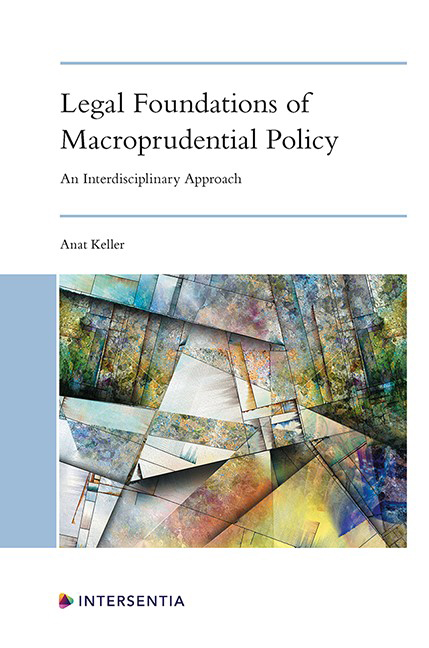Book contents
- Frontmatter
- Dedication
- Contents
- List of Cases
- List of Instruments
- Chapter 1 Introduction and Background
- Chapter 2 A Macroprudential Mandate: How to Operationalise it
- Chapter 3 Institutional and Procedural Design for Macroprudential Regimes: Institutional Models and the Nature of the Decision-Making Process
- Chapter 4 Powers of Macroprudential Authorities and the Use of Soft Law
- Chapter 5 Formulating a Taxonomy of Supervisory Approaches in Macroprudential Policymaking
- Chapter 6 Activating and Calibrating Macroprudential Instruments
- Chapter 7 Independence, Accountability and Transparency of Macroprudential Policy
- Chapter 8 A Non-Dichotomous View of Macroprudential Policy and Other Policy Areas
- Chapter 9 Data Collection and Analysis in Macroprudential Policy: An Epistemic View
- Chapter 10 Th e Global Architecture of Systemic Risk Regulation and Supervision
- Index
- About the Author
Chapter 2 - A Macroprudential Mandate: How to Operationalise it
Published online by Cambridge University Press: 03 October 2020
- Frontmatter
- Dedication
- Contents
- List of Cases
- List of Instruments
- Chapter 1 Introduction and Background
- Chapter 2 A Macroprudential Mandate: How to Operationalise it
- Chapter 3 Institutional and Procedural Design for Macroprudential Regimes: Institutional Models and the Nature of the Decision-Making Process
- Chapter 4 Powers of Macroprudential Authorities and the Use of Soft Law
- Chapter 5 Formulating a Taxonomy of Supervisory Approaches in Macroprudential Policymaking
- Chapter 6 Activating and Calibrating Macroprudential Instruments
- Chapter 7 Independence, Accountability and Transparency of Macroprudential Policy
- Chapter 8 A Non-Dichotomous View of Macroprudential Policy and Other Policy Areas
- Chapter 9 Data Collection and Analysis in Macroprudential Policy: An Epistemic View
- Chapter 10 Th e Global Architecture of Systemic Risk Regulation and Supervision
- Index
- About the Author
Summary
A clear and well-defined mandate is a sine qua non for good governance and a cornerstone of any public policy framework. It forms the basis for the delegation of macroprudential powers, secures the independence of the macroprudential authority and provides a benchmark for holding it accountable (Chapter 7).However, the difficulty of encapsulating financial stability in a simple metric and the lack of an overall analytical framework to guide policy decisions mean that while the articulation of the macroprudential mandate is important it is also extremely challenging.
The aim of this chapter is to explore how to turn the amorphic concept of financial stability into a concrete, practical and achievable macroprudential mandate that can be used as a benchmark to assess the performance of macroprudential authorities and holding them, where necessary, accountable. The chapter thus analyses how the macroprudential mandates of the FPC, the FSOC, the ESRB and the national macroprudential authorities in the EU are articulated and whether there are any common essential ingredients that can be identified. It suggests that in order to operationalise a macroprudential mandate, legislators and macroprudential authorities oft en concretise the term financial stability through using the terms “ systemic risks ” and “ resilience ” . These terms bring focus and clarity to the macroprudential mandate and assist in making it more achievable and measurable compared to the overarching notion of financial stability. Identifying the nature of these terms and their key features will hopefully allow for the refinement of macroprudential policy frameworks and analytical tools. Another useful way to operationalise the macroprudential mandate is through the design and deployment of intermediate objectives that can be linked to specific indicators and tools and be periodically reviewed and adapted to reflect new risks to financial stability.
Following this introduction, the chapter proceeds as follows. Section 1 begins with outlining the mandates of the FPC, FSOC and the ESRB, laying the grounds for their normative assessment in the following sections. Section 2 explores the interpretation and articulation of financial stability as the ultimate objective of macroprudential policy and its comprising elements of strengthening the resilience of the financial system and decreasing the build-up of systemic risks. Section 3 then borrows from insights developed in economics discipline to interpret the meaning of resilience in the context of macroprudential policymaking.
- Type
- Chapter
- Information
- Legal Foundations of Macroprudential PolicyAn Interdisciplinary Approach, pp. 21 - 52Publisher: IntersentiaPrint publication year: 2020



